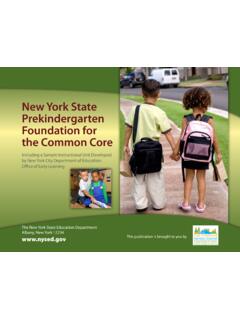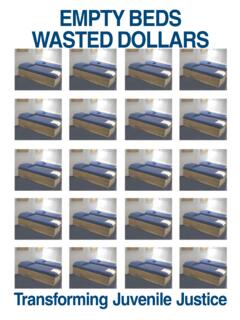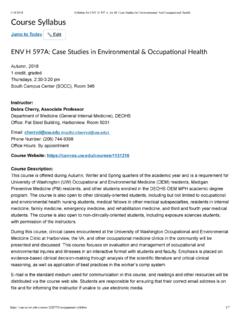Transcription of FASD Case Studies - NYS Council on Children and Families
1 FASD case Studies JACK, an infant, was recently adopted by Bob and Ann an older couple with no other Children . Bob and Ann have reached out to their pediatrician because Jack seems inconsolable, crying often and does not drink regularly from the bottles of formula they fix for him. They are still quite excited about the adoption and wonder what they are doing wrong as first time parents. Dr. Sherman has read extensively on the psychological and social-emotional needs and development of adopted Children and recently viewed the movie, Broken Cord. Broken Cord tells the story of a single man who adopts a young boy who then begins to show signs of mental illness but which are in fact, symptoms and behaviors of fetal alcohol syndrome.
2 Dr. Sherman is quick to notice unique facial features such as wide set eyes, smooth philtrum and low nasal bridge coupled with Jack s poor feeding and crying as Fetal Alcohol Syndrome. The diagnosis is both a relief and a shock to Bob and Ann, a shock because they never thought they weren t adopting a perfectly healthy boy and a relief in that now they can move forward and address Jack s development within the context of fetal alcohol syndrome. MIRANDA, a sweet curly haired 18 month old toddler, is the middle child of a professor father and stay at home mother, who has just given birth to her third child. Miranda has been enrolled in a nearby day care/nursery school. After the initial assessment, the lead teacher mentioned several items that she wanted to work on with Miranda and her parents.
3 The teacher noticed Miranda doesn t verbalize many words and was quickly overwhelmed by easy instructions. Miranda s parents report that Miranda s older sibling, Chris, is doing remarkably well in school and that Miranda does not seem to enjoy the same activities that Chris did as a toddler. Miranda has wide set eyes and a smooth philtrum. She is a smiley child, very affectionate and inquisitive of her surroundings. JAY is an adorable, petite 5 year old boy who lives with his mother, Sandi. Jay was born 2 months premature. Sandi admitted to using alcohol and crack cocaine during her pregnancy. At age 7 months, Jay had a grand mal seizure which resulted in a 4 day hospital stay, where they found evidence of brain damage.
4 Jay qualified for Early Intervention (EI) services and received occupational and physical therapy, and special education teacher services in a home based program. At age 2 he moved to a school based integrated program where he received more intense services. He has made slow but steady gains in his program. Jay just started speaking at 4 years of age, but has continued to use sign language to support his newly found skills. At this time he is still not potty trained. Jay takes medication for a seizure disorder. He was also started on a low dose of a stimulant medication due to concerns with attention deficit. This has helped with his progress in school. Sandi has been sober for more than two years now and reports that Jay is a joy to have at home.
5 He is a fussy eater and doesn t like certain clothing, but she has found ways to help him with the support from the occupational therapists at the EI program. Jay is curious about his surroundings and will get into things he shouldn t. Jay becomes anxious when leaving the house and this has limited the amount of things she is able to do with him when he is not in school. Sandi will be attending the Committee on Special Education (CSE) meeting to find appropriate resources for Jay as he enters kindergarten. JACK (infant) The infant was seen by a FASD specialist in Buffalo who confirmed the pediatrician s suspicions of a diagnosis of Fetal Alcohol Syndrome or FAS. Jack will be followed by Dr. Sherman, the pediatrician, and enrolled in early intervention services for sensory integration therapy with an occupational therapist.
6 During Jack s early intervention evaluation, the staff utilized the Infant-Toddler Sensory Profile, Brazelton Neonatal Behavioral Assessment Scale and the Bayley Scales of Infant Development to gauge Jack s strengths and weaknesses. Together these assessments provided the early intervention team, and later Dr Sherman, a comprehensive picture of how Jack s brain and body are developing and his reactions to several stimuli, which can help in formulating a treatment plan for Jack. Jack is experiencing sensory integration problems that results in crying and waking himself up from naps, causing irritability. Bob and Ann have learned by experimentation what consoles Jack and are beginning to prevent such episodes of irritability.
7 Some efforts that have calmed Jack down are decreasing the light in his bedroom when he is awake. Bob and Ann do not have the radio tuned to the oldies station as they have found that Jack is sensitive to the loud sounds in many commercials. They have also learned to wash Jack s clothes twice with fabric softener in order to decrease the tactile contrast. Also, if the clothing has tags, they are careful to cut them out before putting them on him. They are also careful about what they choose for clothing and has to be very soft. MIRANDA (18 month old toddler) has been attending her preschool for several months now and seems to thrive in the daily routine. She laughs often and is very affectionate with her teachers.
8 She loves to play outside and dance to music at music time. However, Miranda has had several disruptive episodes during class transitions and she hit another child while playing with blocks. Miranda s lead teacher has recommended an assessment with the Early Intervention (EI) team of the local health department. She is concerned about Miranda s delayed language development and continued disruptive behavior. Miranda s parents are reluctant to call Department of Health for the testing and her mother seems overwhelmed with caring for the new baby, twice arriving late to pick Miranda up from preschool. An early intervention testing session was scheduled for Miranda at morning drop off time so both parents could attend.
9 The preschool arranged for a teacher to watch Miranda s infant brother so her parents could concentrate on Miranda and the evaluation. The early intervention team consisted of a speech pathologist, a pediatric public health nurse, and an occupational therapist. They worked together and evaluated Miranda on a variety of gross and fine motor skills, language retention and pronunciation, and attention span. The EI team recommended speech therapy to help with Miranda s language development and occupational therapy to help with transitions and positive social behaviors. These services could happen at preschool during regularly scheduled class time so Miranda would keep her same daily schedule of coming to and going from school.
10 This situation was beneficial to Miranda s parents who did not have to re-arrange their schedules at this time. Miranda parents seemed more engaged in Miranda s development and successes at school after the EI assessment, They continue to report mini-tantrums from Miranda but with less intensity and her mother mentioned that using techniques from the EI team discussions helped her a lot at home. JAY (age 5) During the CSE meeting, the team decides to place Jay in the least restrictive setting to see how he will do, and enrolls him in a regular full-day kindergarten. Sandi reluctantly agrees. The school psychologist has reviewed his records from Early Intervention and notes that Sandi is a recovering alcoholic.












